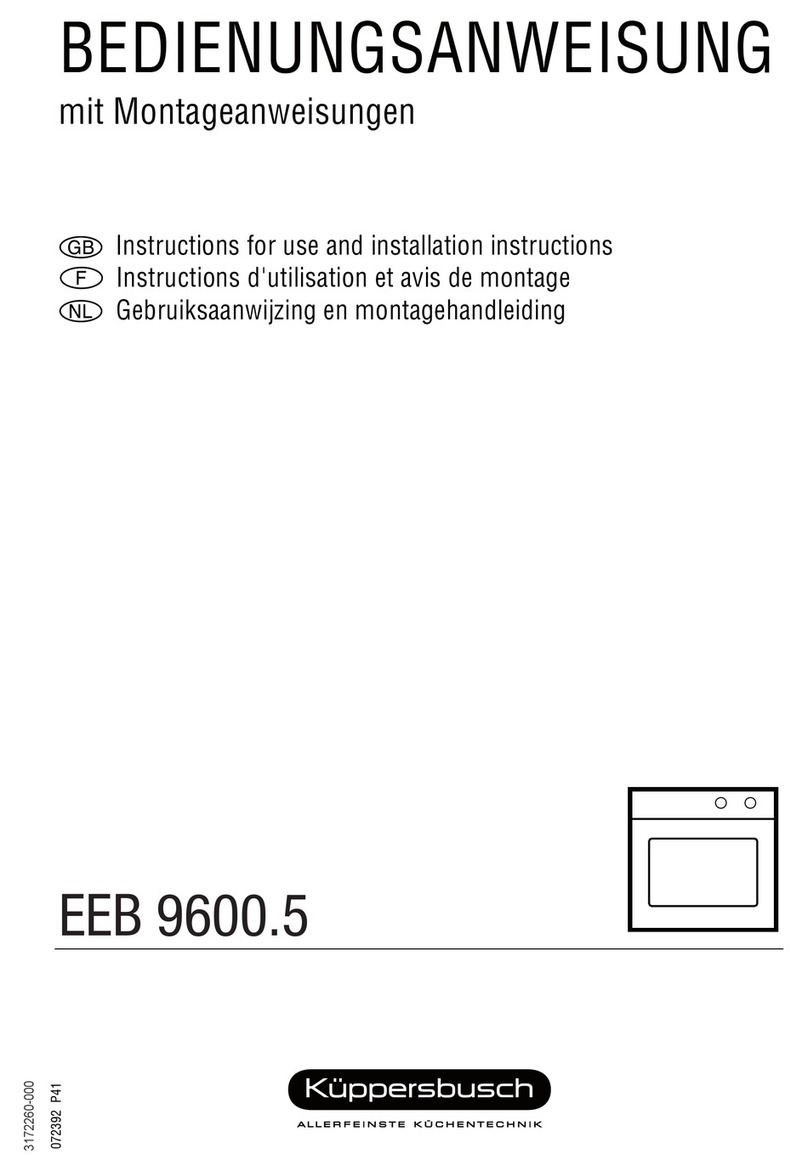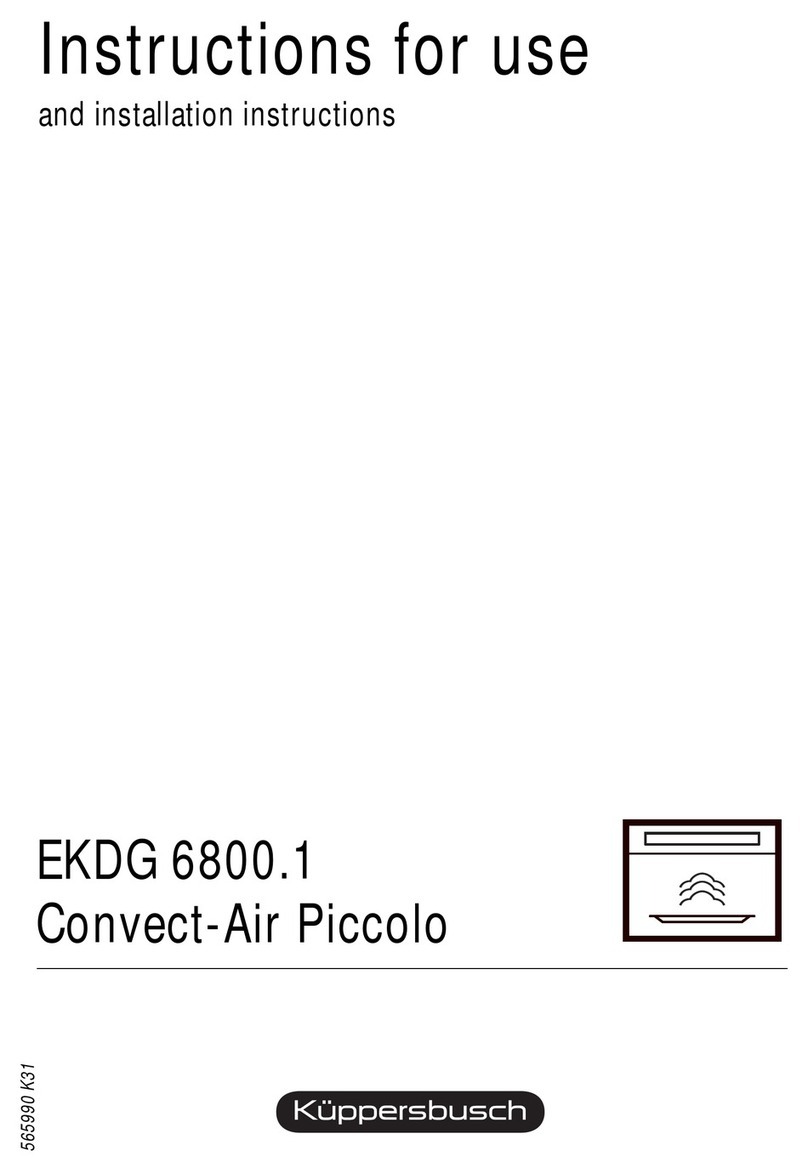EEB 9600.0 23
Fast preheating
FDo not insert food for roasting or baking into the oven until fast preheating
is over and the oven has been set to the normal mode of operation.
FWith the Pizza mode the empty oven can be preheated in a relatively
short time.
– Close the oven door.
– Set the mode selector to Pizza mode .
– Set the temperature you want. The heating-up indicator comes on.
– As soon as the heating-up indicator goes off, set the mode you want.
– Put the food into the oven.
Baking
Quantities for one baking tray (e.g. cake mix, yeast dough):
Cake mixture
350 g shortening, 270 g sugar, 1 vanilla sugar, 6 eggs, 670 g flour,
6 level tsp. baking powder
Yeast dough
670 g flour, 50 g yeast, 1 tsp. sugar, 1/4 l milk, 100 g sugar, 2 eggs,
1 vanilla sugar, 100 g margarine.
Hot air convection #
FNo need to preheat the oven - baking is possible on several levels
simultaneously.
Rack levels
1 tray: 3rd rack level from the bottom
2 trays: 3rd and 6th rack levels from the bottom
■ If you are baking several cakes in baking tins, about 10 to 15 minutes
additional baking time will be needed for each baking tray.
■ Remove the baking trays individually, depending on how well browned the
cakes are.
■ Bake using hot air convection # , at a temperature of 160°C. If there are
no instructions for baking by hot air convection in your recipe.
■ Important! When cakes with a moist fruit topping are being baked, the
development of humidity is particularly high. Bake only one such cake at a
time.
Top/Bottom heat $
FPreheating - baking on one level
■ Preheat the oven by Pizza mode , and when the temperature has been
reached, set the oven back to Top/Bottom heat $ .
■ Baking tins made of black metal and aluminium are particularly suitable.
Intensive hot air convection 0
FNo need to preheat the oven - baking on one level
■ Only for large flat cakes with a dry topping, such as a crumble topping.
Pizza mode
FBaking on one level
■ for moist cakes
■ for pizzas: preheat the oven with a baking tray or a pizza stone (accessory)
■ for bread: preheat the oven
Baking pizza
FSelect the Pizza mode at 250°C.
– If you use a pizza stone (special accessory), the pizza gets a particularly
crispy base. Preheating time: at least 30 min.!
Read the instructions enclosed with the pizza stone.
Basic recipe for pizza
375 g of flour, 20 g of yeast, 1/8 l of lukewarm water, 3 tablespoons of (olive)
oil, salt.
Baking pizza on a baking tray
– Make a yeast dough out of the specified ingredients.
– Allow the dough to rise for approx. 30 minutes until it has doubled in size.
– Then knead the dough for a few minutes and allow it to prove for another
15 minutes.
– Preheat the oven in Pizza mode and at a temperature of 250°C.
– Grease the baking tray.
If you are making small round pizzas, insert the baking tray into the oven
now and preheat it as well.
– Roll out the dough, place on a baking tray and form an edge.
– Add any topping you want quickly so that the dough does not become moist.
–Small pizzas: put topped dough onto the preheated baking tray.
– Place the baking tray in rack level 0.
– Bake for approx. 15 minutes in Pizza mode , at a temperature of 250°C.
Baking pizzas on the pizza stone
– Prepare the pizza dough as described above.
– Place the pizza stone on the gridiron and insert at rack level 0.
– Preheat the oven in Pizza mode and at a temperature of 250°C.
– Place the dough onto the floured lifter and add toppings quickly so that the
dough does not become moist. The topped pizza must not lie too long on
the lifter as otherwise the dough no longer slides off.
– When preheating is over, push the pizza off the lifter onto the hot pizza
stone.
– Bake for approx. 15 minutes in Pizza mode , at a temperature of 250°C.
Tips on the table “Recommended temperatures
for baking”
The table on page 24 contains a selection of cakes etc., the necessary
temperatures, cooking times and rack levels.
■ Temperatures are generally given in ranges as they depend on the
composition of the dough, the quantity and the shape.
■ We recommend you to set the lower temperature value the first time and
only select a higher temperature if necessary, e.g. if you want more
browning or the baking time is too long.
■ If you do not find any specific temperatures for your own recipes, use a
similar cake in the table given as a reference.
■ Height differences of the food can result in different degrees of browning at
the start of the baking process. In this case please do not change the
temperature setting. Differences in browning are offset during the course of
baking.



















































